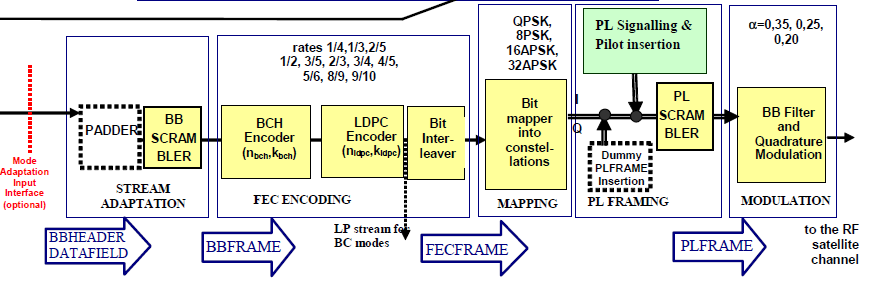- Table of contents
- 2.3 DVB-S2 standard
2.3 DVB-S2 standard¶
Digital Video Broadcasting – Satellite 2nd Generation (DVB-S2) is a broadcast standard defined by ETSI (European Telecommunications Standard Institute) http://www.etsi.org/ in ETSI EN 302 307 [1] for satellite TV. It includes a powerful FEC system on LDPC (Low Density Parity Check) codes concatenated with BCH (Bose-Chaudhuri-Hocquenghem) codes, allowing Quasi-Error-Free operations very close to the Shannon Limit. It uses a wide range of code rates, QPSK, 8PSK 16APSK, 32APSK constellations and shape filtering with roll-off factors 0.35, 0.25 and 0.2. Of course the purpose of this project was not to implement the ETSI EN 302 307 but a simplified version in order to make performance calculations and observations over the USRPs.
DVB-S2 standard was conceived in 2003, in order to replace the DVB-S standard [2] introduced in 1995. The need for broadcast services in HDTV and 3DTV drove the evolution of the DVB-S standard. In early 2014, the DVB Project https://www.dvb.org/ standardized the DVB-S2X standard [3] with higher order modulations and smaller roll-off factors, improved spectral efficiency. Broadcast Satellite Service (BSS) uses specific frequency bands for each ITU Region in tha K_u band.
| Table 2.2 Broadcasting Frequencies | |
| Frequency band | ITU Regions |
| 11.7-12.2 GHz | ITU Region 3 Asia and Australia |
| 10.7 - 12.75 GHz | ITU Region 1 Europe, Russia and Africa |
| 12.2-12.7 GHz | ITU Region 2 North and South America |
In Table.2.3 we present some of the improvements that were introduced in the Second Generation DVB-S2 standard in comparison with the DVB-S. In DVB-S the data format was exclusively the MPEG Transport Stream, whereas DVB-S2 supports GSE (Generic Stream Encapsulation) enabling the protocols such as IP (Internet Protocol) on top of uni-directional layers. Variable coding and modulation (VCM) enables different streams-services to be coded with different (fixed) parameters on the same carrier, e.g. SDTV could use a more robust setting than HDTV. Adaptive Coding and Modulation (ACM) can handle each frame to be coded with different set of parameters, which are modified according to the reception conditions of the receiver.
| Table 2.3 DVB-S2 Improvements | |
| DVB-S | DVB-S2 |
| Transport Stream (MPEG) | Generic Mode & MPEG4 |
| Constant Coding & modulation | Adaptive/adaptive Coding & modulation |
| Reed-Solomon & Viterbi | LDPC & BCH |
| BPSK, QPSK, 8PSK, 16QAM | BPSK, QPSK, 8PSK, 16APSK, 32APSK |
| Pilots N/A | Pilots |

Figure 2.5 DVB-S2 - Project Case of Study
2.3.1 References¶
[1] ETSI EN 302 307
[2] ETSI EN 300 421
[3] ETSI EN 302 307-1
